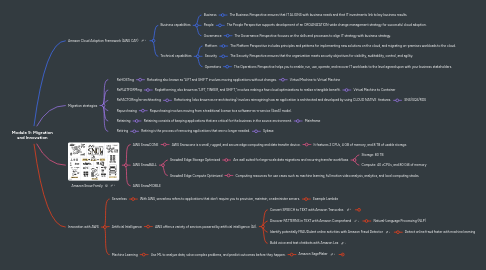
1. Amazon Cloud Adoption Framework (AWS CAF)
1.1. Business capabilities
1.1.1. Business
1.1.1.1. The Business Perspective ensures that IT ALIGNS with business needs and that IT investments link to key business results.
1.1.2. People
1.1.2.1. The People Perspective supports development of an ORGANIZATION-wide change management strategy for successful cloud adoption.
1.1.3. Governance
1.1.3.1. The Governance Perspective focuses on the skills and processes to align IT strategy with business strategy.
1.2. Technical capabilities
1.2.1. Platform
1.2.1.1. The Platform Perspective includes principles and patterns for implementing new solutions on the cloud, and migrating on-premises workloads to the cloud.
1.2.2. Security
1.2.2.1. The Security Perspective ensures that the organization meets security objectives for visibility, auditability, control, and agility.
1.2.3. Operations
1.2.3.1. The Operations Perspective helps you to enable, run, use, operate, and recover IT workloads to the level agreed upon with your business stakeholders.
2. Migration strategies
2.1. ReHOSTing
2.1.1. Rehosting also known as “LIFT and SHIFT” involves moving applications without changes.
2.1.1.1. Virtual Machine to Virtual Machine
2.2. RePLATFORMing
2.2.1. Replatforming, also known as “LIFT, TINKER, and SHIFT,” involves making a few cloud optimizations to realize a tangible benefit.
2.2.1.1. Virtual Machine to Container
2.3. ReFACTORing/re-architecting
2.3.1. Refactoring (also known as re-architecting) involves reimagining how an application is architected and developed by using CLOUD NATIVE features.
2.3.1.1. SNS/SQS/RDS
2.4. Repurchasing
2.4.1. Repurchasing involves moving from a traditional license to a software-as-a-service (SaaS) model.
2.5. Retaining
2.5.1. Retaining consists of keeping applications that are critical for the business in the source environment.
2.5.1.1. Mainframe
2.6. Retiring
2.6.1. Retiring is the process of removing applications that are no longer needed.
2.6.1.1. Sybase
3. Amazon Snow Family
3.1. AWS SnowCONE
3.1.1. AWS Snowcone is a small, rugged, and secure edge computing and data transfer device.
3.1.1.1. It features 2 CPUs, 4 GB of memory, and 8 TB of usable storage.
3.2. AWS SnowBALL
3.2.1. Snowball Edge Storage Optimized
3.2.1.1. Are well suited for large-scale data migrations and recurring transfer workflows
3.2.1.1.1. Storage: 80 TB
3.2.1.1.2. Compute: 40 vCPUs, and 80 GiB of memory
3.2.2. Snowball Edge Compute Optimized
3.2.2.1. Computing resources for use cases such as machine learning, full motion video analysis, analytics, and local computing stacks.
3.3. AWS SnowMOBILE
4. Innovation with AWS
4.1. Serverless
4.1.1. With AWS, serverless refers to applications that don’t require you to provision, maintain, or administer servers.
4.1.1.1. Example Lambda
4.2. Artificial Intelligence
4.2.1. AWS offers a variety of services powered by artificial intelligence (AI).
4.2.1.1. Convert SPEECH to TEXT with Amazon Transcribe.
4.2.1.1.1. Speech Recognition Service
4.2.1.2. Discover PATTERNS in TEXT with Amazon Comprehend
4.2.1.2.1. Natural-Language Processing (NLP)
4.2.1.3. Identify potentially FRAUDulent online activities with Amazon Fraud Detector
4.2.1.3.1. Detect online fraud faster with machine learning
4.2.1.4. Build voice and text chatbots with Amazon Lex
4.3. Machine Learning
4.3.1. Use ML to analyze data, solve complex problems, and predict outcomes before they happen.
4.3.1.1. Amazon SageMaker
4.3.1.1.1. AWS offers Amazon SageMaker to remove the difficult work from the process and empower you to build, train, and deploy ML models quickly.
